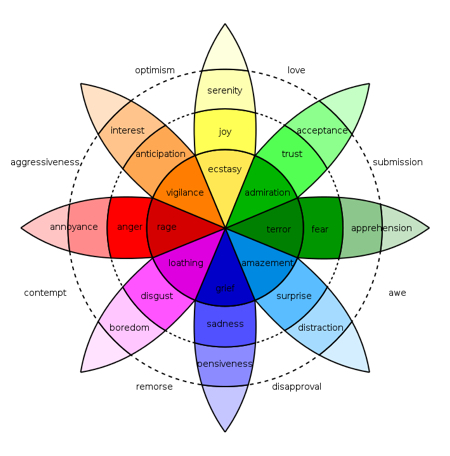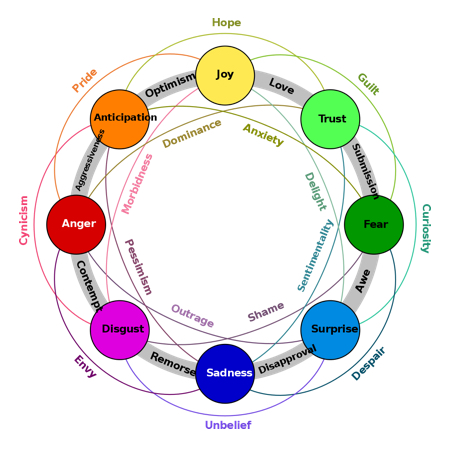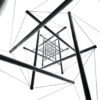
There are many models for capturing the range of human emotion, but one that caught my eye was this highly original classification captured in the wheel of emotions. This image is the work of Robert Plutchik, a psychologist who saw emotions, as Darwin did in his groundbreaking The Expression of the Emotions in Man and Animals, as playing a role in the evolution of animal life. He posited that all animals, including humans, share the “primary” emotions.
I’m not a fan of evolutionary psychology as it has been applied recently to depression itself, but Plutchik presents the complexity of emotions in an interesting and helpful way.
The primary emotions are the eight shown in the middle of the three circles of this figure, and he groups them as four pairs of opposites: fear vs. anger, surprise vs. anticipation, joy vs. sadness and trust vs. disgust. These are the emotional states shared by many animals in different degrees. Plutchik captured the increasing complexity of emotions by comparing them to a color wheel. Just as colors have different levels of intensity, so do emotions. In this diagram, he shows the less intense in the outer circle and the most intense in the center.
For example, the progression of intensity leads from serenity to joy to ecstasy, from annoyance to anger to rage, from acceptance to trust to admiration, etc. (I can’t see, though, how boredom is the less intense form of loathing – but there’s lots to quibble about here.)
The emotions in the outermost white band are more complex human states of feeling, such as love or remorse, that grow out of the primary states. So love is linked to joy and trust, contempt to anger and disgust, awe to fear and surprise, and so on.

Plutchik also organized emotions as pairs or dyads in the second diagram. The dyad arrangement shows links among primary emotions in a more flexible manner than the wheel. These links reveal additional emotions, like shame, dominance, curiosity and despair. An interesting feature of this diagram is the multiple levels of links. The primary emotions can merge in several directions among the subsidiary feelings. Hence, anticipation and sadness yield pessimism, surprise and anger yield outrage, fear and disgust produce shame, and so on.
There’s a lot I don’t agree with in this classification. Partly, that may result from some of the name choices he makes, such as submission. That seems more appropriate word for the action that follows an emotion rather than the emotion itself. Some of the associations are questionable, but it’s interesting to think about this classification and how emotions are linked and blended.
Plutchik also related the primary emotions to a sequence of adaptive or defensive behaviors in the following table (from Theories of Emotion by Robert Plutchik and Henry Kellerman. New York: Academic Press. 1980.)
| Stimulus event | Inferred cognition | Feeling | Behavior | Effect |
|---|---|---|---|---|
| Threat | “Danger” | Fear, terror | Running, or flying away | Protection |
| Obstacle | “Enemy” | Anger, rage | Biting, hitting | Destruction |
| Potential mate | “Possess” | Joy, ecstasy | Courting, mating | Reproduction |
| Loss of valued person | “Isolation” | Sadness, grief | Crying for help | Reintegration |
| Group member | “Friend” | Acceptance, trust | Grooming, sharing | Affiliation |
| Gruesome object | “Poison” | Disgust, Loathing | Vomiting, pushing away | Rejection |
| New territory | “What’s out there?” | Anticipation | Examining, mapping | Exploration |
| Sudden novel object | “What is it?” | Surprise | Stopping, alerting | Orientation |
This table is especially interesting to me because it moves all the way from the stimulus through feeling to behavior and finally the emotional and psychological effect of the overall experience. So reintegration is the effect of the experience of grieving for the loss of a valued person.
This sort of sequence also offers a way of linking perception, the immediate thought responding to that perception, feeling, behavior and a kind of resolution of the experience. It’s much more sophisticated and helpful than the simplistic idea that thought gives rise to feeling which gives rise to behavior – a formulation commonly found in discussions of cognitive therapy.
What do you think of this?
Image credits: Wheel of Emotions by Machine Elf 1735 / Public domain
Plutchik’s Dyads by ChaoticBrain / CC BY-SA


I try to to take the wheel too literally. Any 2 dimensional rendering of the range of human emotions will likely fall short. However, the classifications can help clarify characters and raise interesting questions on similarities and difference between characters.
For example, I know my protagonist was Angry at the world. Going through all the primary and secondary emotions I realized that Contempt was a better description. Part of Contempt is Anger. But the other variable in the equation that I didn’t consider was Disgust, which, in the case of my character was the result of a moral judgement. Interesting and helpful. Then I realized that the antagonist, who came from a similar background, was also Angry. But he was more driven than the protagonist to take over the world. Anger + Anticipation = Aggression.
Then it hit me that the difference between the two characters was that the Protagonist had a moral stance on the world whereas the antagonist was just an opportunist who didn’t care to take a position on it. Well… if the two characters came from the same place and were both angry, then why was one moral and the other amoral? etc.
Such a great thought exercise for me. Really forces me to consider the nuances of emotion and where are similar and where they conflict.
When I first saw this colour wheel I thought “what an amazing enterprise – how did I not come across this before!” Then I looked closer and there is so much that doesn’t work about it that it suggests that the efforts to make it elegant (emotions forced to fit the pretty pattern) has left so many inaccuracies that the both primary emotions themselves must be wrong as well as the emotions biased towards english terminology rather than universal expressions of emotion – leading to a lot of combinations and opposites that don’t make any sense. The theory doesn’t hold at all.
Clearly guilt is not joy and fear. Guilt is an emotion through the realisation of having done something wrong that risks rejection from the group. There may be fear of consequences in that, but no joy. You can feel guilty without having a “guilty pleasure” where you have simply done the wrong thing and feel “bad” about it – no. joy. at. all. Let alone being half of the feeling all of the time.
Anger and fear are not opposites in they don’t lead to opposite but complementary action – hence anger is frequently a secondary emotion in response to fear – both based on survival. An opposite of fear would be more like interest or curiousity.
Trust as a primary emotion seems wrong. A primary emotion would have a clear physical action tendency.
I think the original error is in trying to have a balance between pleasant (reinforcing) emotions vs unpleasant (aversive) emotions which doesn’t exist in reality.
Hi John,
Thanks for your explanation about fear and anger being opposites… When you explain it like that it makes perfect sense! Yes… They are opposing reactions to a dangerous situation (although whether, in tht situation, we always fight out of ‘anger’ exactly I don’t know…) I do see now how they can be opposites!
I looked up Plutchik and tried to have a read of some other things to help make sense of his ideas but haven’t found a huge amount of stuff and haven’t had a whole lot of time to read things as it’s second week of new year and have been so busy!
Thanks for making it clearer.
Warm wishes
Thinking about emotions in this way is deeply interesting to me too, and it’s a project I’ll never be done with. Let me know if you find anything else by Plutchik – I’ve only come up with a couple of pages giving a general overview of his thinking.
John
Hi John,
I’ve come back to this as I needed a little time to get my head around it.
It’s an interesting explanation of how emotions relate to each other.
Having given it some thought I have to say that I agree with a few of your points, inasmuch as I struggle with some of his word choices and classifications.
You are right! How boredom and loathing relate eludes me, as do a few of his assertions about opposites…
Terror and rage / fear and anger are opposing emotions? Perhaps anger and acceptance, fear and serenity???
I’m also very unsure about love being the opposite of remorse. Something lost in translation somewhere?
I disagree that “vigilance” is an emotion and suspect that Plutchik was thinking more in terms of animals than humans when he included this.
Now I have ripped it apart, I would like to add that whilst I have problems, again, with his word choices, I really liked the way his wheel connected emotions and showed how mixtures of the primaries resulted in ‘combination emotions’. I thought a couple of these were particularly accurate.
So. There you go! You did ask!
I have absolutely no qualification which would entitle me to give a valid criticism of his model so I feel a bit cheeky really..! But, those are just some thoughts that I had!
Thanks for such an interesting post.
Hi, WS –
It does take a while to ponder – I’m still at it. I was trying to understand vigilance too. There’s some sort of feeling attached to alertness, wariness, readiness to spring into action though I’m not sure what to call it. Plutchik’s system apparently separated the feeling aspect as just one part of emotion – which consists of the complicated series of neural and cognitive reactions set off by a stimulus. So his idea of emotions is different from what we normally think of – he’s trying to avoid a subjective approach. I’m trying to find something of his that would explain this more thoroughly.
I do believe fear and anger are opposites, though – at least as reactions to a threat. Either you get angry and attack or become fearful and retreat. That’s the primal pair associated with the stress flight-or-fight response to those cortisols that get released in the brain when your neighborhood monster unexpectedly taps you on the shoulder. Beyond that link, you’re right that the pairing of opposites could come out in many different ways.
Thanks for your reactions – just what I was hoping for!
John
john,
As always you amaze me but i never thought of this before. it’s really stimulating. I really need to think this over.
i wish my life was more simple with emotions like a dogs or cats. just eat, sleep, play and poop.
Hi, Susan – On simplicity, I think it might get a little boring to scale back to cat and dog emotions – though perhaps for a weekend, now and then? But Plutchik was convinced that we share far more of the emotions with animals than most psychologists believe. Interesting to think about.
Good to see you here!
John
Very interesting John. I plan on coming back to spend more time reading it!
Susan
Hi, Susan –
It does take a while to get a sense of what he’s doing. Unfortunately, he doesn’t seem to have written a great deal – at least that I can find online, just a couple of short pieces. I’ll look into his bibliography some more.
John